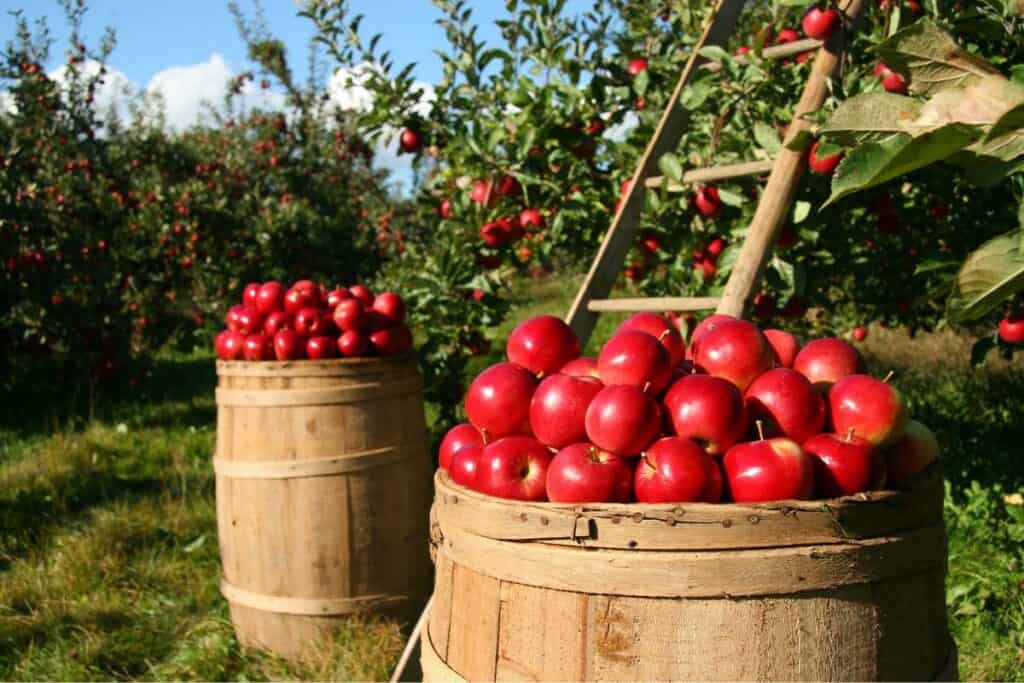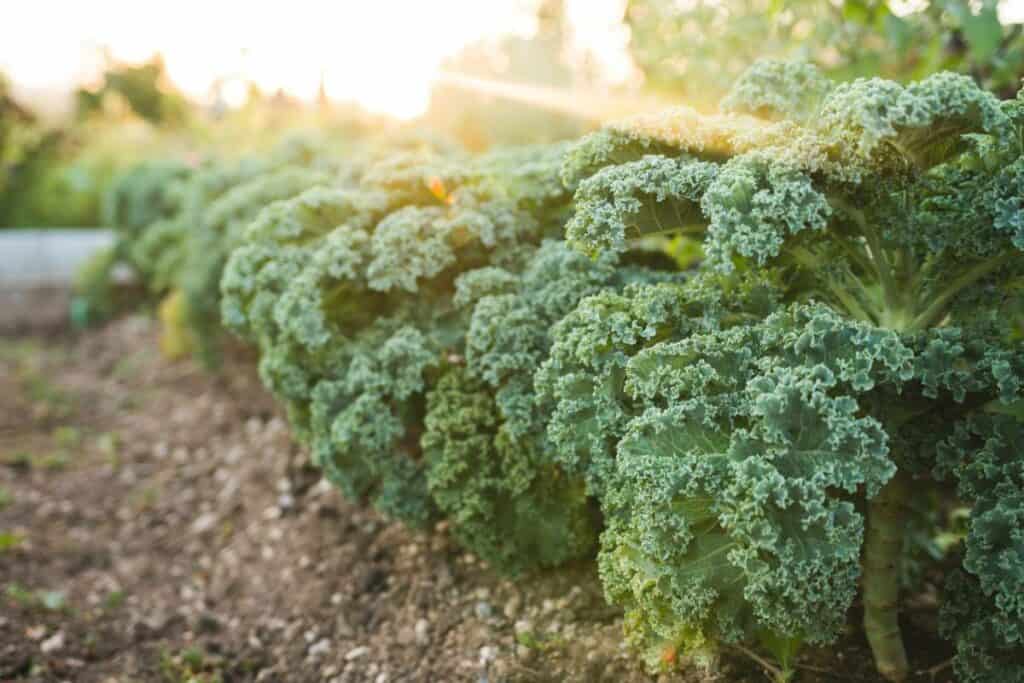There are a lot of things we love about being Registered Dietitians. From recipe development, to staying on top of current nutrition recommendations, to providing education, to of course, making connections with the folks who grow and care for our food – farmers.
Unfortunately, in our busy world, especially as parents, it’s easy to forget how our food gets to our plate. We stroll down the aisles of grocery stores, tossing items into our carts without giving much thought to where it came from. Don’t worry though, that’s why we’re here! In this blog post, we’re going to share 5 Things You May Not Know About Where Your Food Comes From.
1. Most Farms Are Family Owned and Operated
Once upon a time in 1931 3,289,140 people were living on a farm, for context that’s 31.7% of the Canadian population. Well, fast forward to today only about 2% of our population works in farming. That means there are fewer people growing more food, for more people. It’s a big job!
Large or small, the vast majority of Canadian farms are actually family owned and operated. By vast majority, it’s about 97% percent so one can argue that almost all farms in Canada (and U.S.) are family-run businesses. Parents, and even grandparents, often work together with their children and grandchildren in the family’s farming business.
One of the perks of our jobs is that we get to tour farms and connect with farm families. We’re always amazed to learn about how farms are handed down from one generation to the next in a process called succession. And while it might be tough to connect with a farmer where you live, you can actually hear farm stories straight from the farmers by watching the series on Real Farm Lives or even more locally for us, Manitoba farmers on the Great Tastes of Manitoba.
So yes, you may hear the term “big ag” being used to paint a picture of impersonal corporations that only care about financial gain, but this is largely a hoax. While most family farmers incorporate for accounting and business reasons, it doesn’t make them any less “family owned” and they certainly care about the land that is going to support their families for generations to follow.
Speaking about caring about the land, this brings us to our next point…

Climate change.
Food security.
Sustainability.
Environmental impact.
Deep breaths! These are all words you might be hearing more and more in the context of our global food system and they are heavy. But luckily, we can count on farming and agriculture to contribute positively to these issues because truthfully, the ability to access affordable, safe and nutritious food is a basic human right.
Did you know that Canadian farms are actually producing 390% more food today than they did in the 1960s? Highly regulated pesticides help farmers protect their crops from insects, weeds and disease. Biotechnology has allowed scientists to develop seeds that can produce more, even when faced like challenging conditions, like drought. To add, thanks to technological advances, we’re able to use less fossil fuels and prevent the deterioration of soil health.
If you’re reading this article, there’s probably a good chance you live in a food-secure community. But the truth is, not everyone does. What about families who live in food deserts where food is difficult to grow? The answer isn’t just to grow more food. It’s going to be growing more, with fewer resources. Without plant science innovations, Canadian farmers would need 44% more land to grow the same amount of food they do today.
At the end of 2022, we had an opportunity to attend the GrowCanada conference and hear Kirstin Beardsley the CEO of Food Banks Canada speak to the growing issue of food security in our country.
Here are a few fast (but heart breaking) facts:
- 33% of those accessing food banks are children
- In Manitoba (our home province) more children are using food banks — over 15,000 children per month were among food bank users in 2022
- The percent of seniors accessing food banks has increased from 6.8% in 2019 to 8.9% in 2022
- The percent of Indigenous people accessing a food bank has almost doubled from 2021 to 15.3% in 2022 and they are disproportionately represented
- More and more university students are relying on food banks for their next meal, when they should be studying (these students are our future)
Hearing this can feel crummy. But we can use this to fuel our passion for giving, for policy change and to support our friends in agriculture who really…are working hard to feed the world more food, with fewer resources and reduce environmental impact.

If you haven’t visited a Canadian farm recently, your idea of what’s going on might be limited to what you see in your baby’s picture books – the classic image of a man in overalls with a straw hat riding a tractor! Or maybe a woman in a long flowy skirt with a basket full of produce.
The truth is – farms are some of the most technologically advanced “smart” spaces there are! There’s a ton of technology to make farming more efficient, thus making it more environmentally sustainable and playing a key role in our food waste reduction.
Here are some example of how modern tech has prevented food loss:
- Biotechnology has allowed for a new variety of apple that doesn’t brown when bruised or cut!
- Plant breeding has increased crop production by 50% over the past one hundred years
- Field analysis allows farmers to know how much fertilizer to apply to each square foot instead of their fields, instead of putting the same amount across the whole field
- Temperature monitors alert poultry farmers if barn temps go too hot or too cold and back-up generators kick in automatically if there’s a loss of electricity
- Edible film coatings that keep oxygen out and moisture in double the shelf life of produce
- Drought-resistant seed varieties allow crops to be grown in less-than-ideal conditions
Considering that wasted food ends up in our landfills contributing to methane production (a greenhouse gas that leads to climate change), creating solutions to this problem also doubles down to support environmental sustainability!

What would you have to cut out if your groceries cost $4500 more?
- For some that might mean saying goodbye to that trip to Disney.
- For some that might mean letting go of the second vehicle.
- For some that might mean the kids don’t get to play hockey or take piano lessons.
- And for some that might mean going 45% hungrier because there isn’t anything “extra” to cut out.
Thanks to plant science innovations, you don’t have to make those sacrifices! It’s calculated that our grocery bills would otherwise be 45% higher without the use of pesticides, translating to about $4500 more each year for the average household.
This is partly attributed to how much harvest would be lost due to insects, weeds, and diseases if farmers could not protect their crops. It’s economics 101 – when the supply of a product goes down, the demand goes up, driving the price up with it.
5. You’re Not Actually Eating a Lot of Pesticides
The good news is that all this increased production from the use of pesticides doesn’t come with an increased risk to anyone’s health! Contrary to what many people are led to believe, there’s very very very very very very (we could go on) little pesticide residue on the food we eat.
The Canadian Food Inspection Agency (CFIA) sets maximum residue limits (MRL), which refers to the amount of pesticide that can legally remain on a crop. This level is set well below (up to 1000x lower) the amount that could conceivably cause a health concern to humans.
Health Canada scientists “evaluate the toxicity of a pesticide and conduct a risk assessment that looks at the diets of people in Canada.” They do calculations to answer the following question: Assuming someone was eating produce with the highest pesticide residue, how much could they safely eat and still not experience any health problems?
Let’s take kale as an example.
A child could safely eat 3720 cups of kale every day!
I don’t know about you but I’m pumped if my kids eat even half a cup of kale, never mind 3720 cups!
So let’s look at a food that kids tend to eat more of: apples.
A child could safely eat 340 small apples and still not experience any ill health effects!
Government agencies continually monitor whether farmers are following pesticide labels and staying below maximum residue limits. The most recent testing shows that 99.98% of domestic fruits and vegetables are below limits, and 90.4% had NO detectible pesticide residue. So whether you are buying organic or conventional produce, you can feel confident that it is a safe choice for your family.
Monitoring shows that 90.4% of fruits and veggies have NO detectible residue limit!

You might also be interested in: Should I Buy Organic Food for my Baby?
So Much Progress
We’re continually in awe of our Canadian farmers. They’ve made so much progress in producing MORE food on LESS land with FEWER inputs and LESS energy. Now that deserves an applause and a moment of gratitude.
From farm to table, plant science innovations reduce food loss. This is a positive result for fighting climate change and rising food costs, which means fewer people going hungry.
In short, Canadian farmers are working hard to protect the earth while feeding the world!







